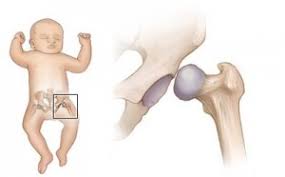- June 20, 2021
- Bartarclinic
- Comment: 0
- Articles, مقالات
Developmental Dysplasia of the Hip (DDH)
Developmental dysplasia of the hip (DDH), also known as congenital hip dislocation, is a congenital condition affecting the hip joint in the region of the thigh bone. In DDH, the head of the thigh bone is not properly located within the acetabulum of the pelvis.
All newborns should be examined by a doctor immediately after birth to check for the presence of this condition. If necessary, further imaging methods such as ultrasound or radiography may be used for further assessment.
Causes of Congenital Hip Dislocation:
The exact cause of this condition is not well understood. It appears that societies in which swaddling infants is common have a higher prevalence of this condition. In contrast, in areas where mothers carry their babies on their backs or in front of their stomachs, the prevalence of this condition is lower.
- The left hip is more commonly affected in congenital hip dislocation.
- It is more common in girls.
- It is more common in infants who have been positioned upside down in the womb (head up and feet down).
Congenital hip dislocation is more commonly seen in the following cases:
- Firstborn children
- white race
- Presence of other congenital abnormalities such as torticollis or clubfoot
The longer the time between birth and treatment, the more pronounced the changes become, making the child’s treatment more challenging. Therefore, the diagnosis and treatment of this condition should be initiated as early as possible.
Symptoms of Congenital Hip Dislocation
Symptoms of Congenital Hip Dislocation
- In the thigh crease area, all infants have natural folds of skin; in this condition, these folds may be uneven on both sides, and the folds in the affected hip area may be more prominent.
- The infant’s hip joint may have limited movement, especially the two hips not opening well apart, and the mother may have difficulty opening the baby’s hips to change diapers.
- Ortolani and Barlow’s Test: These tests are performed by a physician. The infant is placed on their back on a bed, and the physician grasps the infant’s thighs and legs. The hip joint is maneuvered into place with gentle pressure, and then the pressure is released to assess the joint’s stability
The most important symptoms of congenital hip dislocation in children after three months include:
- Limited range of motion of the hip joint: At this age, the ability to spread the legs apart becomes restricted, and it becomes difficult for the mother or physician to separate the child’s legs comfortably.
- Prominence of the greater trochanter bone on the outer side of the hip: The affected side appears more protruded and pronounced than usual.
- Limb shortening: The affected leg appears shorter. When the child is laid on their back with their knees bent so that the soles of their feet remain on the ground, the affected knee is lower than the healthy side. This is known as the Galezzi test.
- Telescope test: Conducted by a physician
- Limping: Children with hip dislocations may start walking later and may exhibit a limp. In unilateral dislocation, when the child lifts the healthy leg off the ground and stands on the affected leg, their entire body tilts towards the affected side. This gait is called the Trendelenburg gait. In bilateral dislocation, the child leans their body towards whichever leg is placed on the ground, leading to a gait known as the waddling gait.
- Increased lumbar lordosis: Particularly in cases of bilateral dislocation, there is excessive arching of the lower back when standing.
Trendelenburg test: Conducted by a physician The patient is asked to stand facing a wall with both hands on the wall for balance. Then, the patient is instructed to lift the healthy leg off the ground and stand on the affected leg. Due to weak abductor muscles of the thigh, the pelvis on the affected side cannot maintain balance, causing the healthy side of the pelvis to tilt downward, and the child compensates by tilting their body towards the affected side.
Diagnosis of Congenital Hip Dislocation:
After a physical examination, the treating physician may use imaging techniques such as ultrasound and plain radiography to make a definitive diagnosis.
Treatment of Congenital Hip Dislocation:
Early initiation of treatment yields better results with simpler methods, a shorter treatment duration, and improved outcomes.
Treatment of congenital hip dislocation in infants:
Treatment of congenital hip dislocation in infants: In newborns, treatment involves using an orthotic device called the Pavlik Harness.
The goal is to position the hip joint in a specific way for a period of one to two months using this harness, allowing the femoral head to stabilize within the acetabulum over time.
Click to view orthotic services
This treatment can be performed on infants up to six months of age.
Usually, when a child starts crawling (around 4-6 months of age), this therapeutic method may not have a significant impact, and further treatment stages should be considered.
Treatment of congenital hip dislocation in the ages between 6 and 18 months
Treatment becomes more challenging if the diagnosis is made between 6 months and 1.5 years of age.
In these cases, the physician attempts to place the patient’s hip joint under general anesthesia in an operating room and maintain the lower limbs and torso in a specific position using a plaster cast for a period of time.
Sometimes, even in infants under six months of age, treatment with the mentioned harness may not be effective, and the physician may resort to reduction and casting.
Treatment of congenital hip dislocation beyond 1.5 years of age often involves surgical intervention in most cases.
In children older than 1.5 years, the shape of the hip bones may have changed, and surgical procedures on the bones are often necessary, besides open reduction for dislocation.
For more information and to contact the clinic, please visit the “Contact Us” section.



